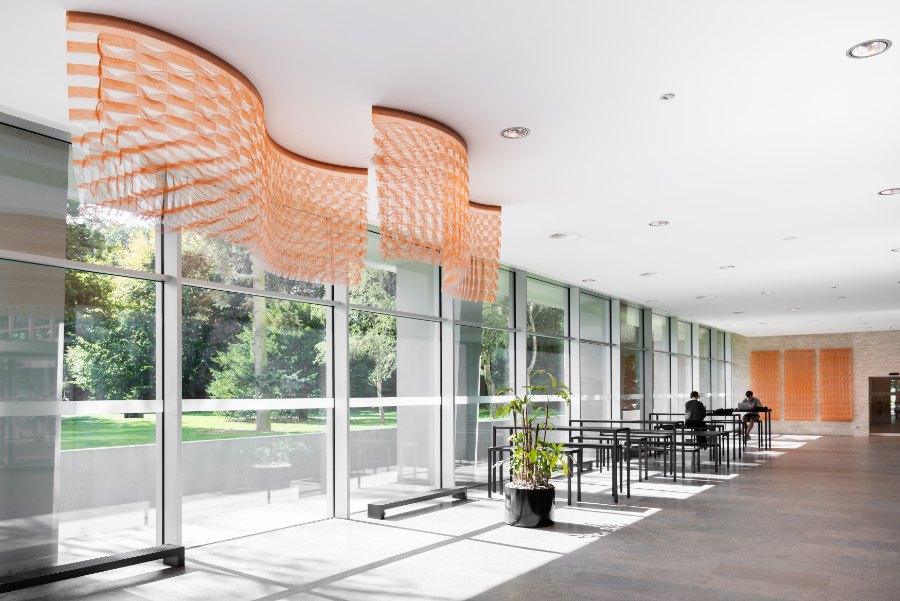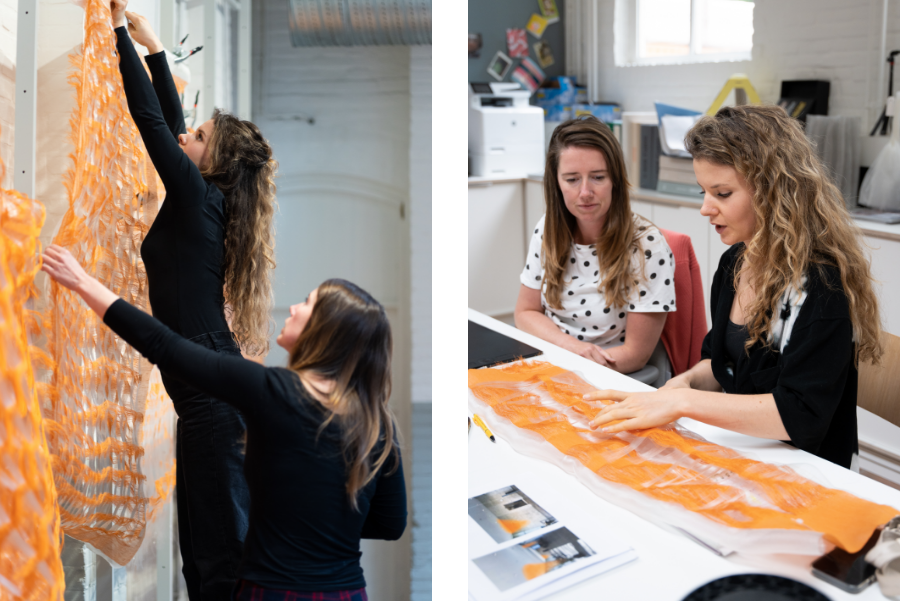“I’m a fan of the TextielLab,” says Wim van de Donk, rector magnificus of Tilburg University. His call to stakeholders in Brabant when he retired as King’s Commissioner resulted in a dream assignment for Fransje Gimbrère: a textile work of art for the university campus.
The entrance to the Koopmans Building at Tilburg University started the academic year with a more welcoming vibe. Since the end of August, a series of textile artworks have broken up the sleek rectangles of glass, concrete and natural stone. Although ‘Physis 1, 2 and 3’ came off the loom in the same rectangular shape, in their new location they demonstrate the versatility of 3D woven structures. Semi-transparent fabrics of monofilament and orange linen undulate and curl along the ceiling of the main hall. The layered grid of loose threads plays with the light and the imagination: the ‘network’ twists, transforms, condenses and splits – sometimes into as many as 16 layers. For those who want to take a closer look at the latter, three sections hang on the wall at eye level.
“This isn’t just a tapestry, it’s a statement.”
Wim van de Donk
A touch of warmth
The aim of the work is to make an atmospheric intervention in the space and invite students to linger. Fransje Gimbrère explains how she wanted to allow nature to continue to grow on the inside of all that glass. “The great thing is that the work looks different as the light changes throughout the day, but also as the seasons pass,” she says. Wim van de Donk, who commissioned the work, is looking forward to these changes. “There are so many aspects of this artwork still to see,” he says. When he retired as King’s Commissioner, he asked Brabant companies and stakeholders not to give the customary gifts but instead to help fund a commission for a young local artist. He didn’t know at the time that the commission would ultimately become a textile work for this university building. But he couldn’t be happier with the outcome. “Science and the arts are closely linked,” he says. “Both require creativity and curiosity. And the Koopmans Building needed a touch of warmth.”

Physis by Fransje Gimbrère in the hall of the Koopmans building. Photo: Patty van den Elshout
Hacking textiles
At a time when art and culture budgets were being cut, he asked the TextielLab to nominate several candidates. Gimbrère’s pitch appealed to Van de Donk for its innovative interventions in Tilburg’s age-old tradition as a textile city. ‘Hacking textiles’ is how Gimbrère describes her high-tech approach to the craft. “I look for new value in existing techniques and crafts.” She has been developing a 3D weaving technique on the TextielLab’s existing industrial machines for some time now. Her interest in 3D stems from the desire to create spatial, self-supporting objects that have an impact on the space. She first did 3D weaving the traditional way, by hand, producing ‘Cirrus’ for the council chamber of Tilburg City Hall. For the same building, she switched to mechanical weaving with the help of the TextielLab, creating the transparent ‘Linum’ partition over three development days. The new assignment for Tilburg University offered Gimbrère the opportunity to deepen her research into mechanical 3D weaving.
“I want to expand the definition of textiles.”
Wim van de Donk
Carte blanche
“Art must be given the space to innovate and develop,” says Van de Donk. Gimbrère had carte blanche in terms of design and execution. Over the course of a year, she spent 15 development days in the TextielLab on this open research project. Together with product developer Judith Peskens, she experimented with weaves and materials to see how they would interact. For the final work, she chose a polyester monofilament warp and a pure linen weft with her own variant of a satin weave – to enhance the 3D effect. “Because both yarns are quite stiff, the material resists gravity better,” Gimbrère explains. “This causes the layers to spread out more and the threads to follow their own course, producing beautiful bends and waves.”

Fransje Gimbrère and product developer Judith Peskens in the Textile Lab. Photos: Patty van den Elshout
Small knowledge bank
Gimbrère and Peskens looked for a balance between holding and letting go, played with the tension differences between weaving and not weaving and overcame the challenges in scaling up from small samples to large pieces. Gimbrère was guided in this process by the technology and behaviour of the material. While some artists come to the lab with a final image in mind, she worked completely the other way around: “We started this research without knowing exactly what would emerge. Ultimately, I built all parts of the ensemble using the same pixel or building block. I duplicated these continuously, as it were, but always in a different way.” Now that the work is in place, Gimbrère is curious to see how it is viewed on campus. For her, it is more than a work of art, it is about making the technology and creative process visible: “I also see it as a kind of small knowledge bank, a proof of concept of a technical innovation from the TextielLab.”
Text: Willemijn de Jonge